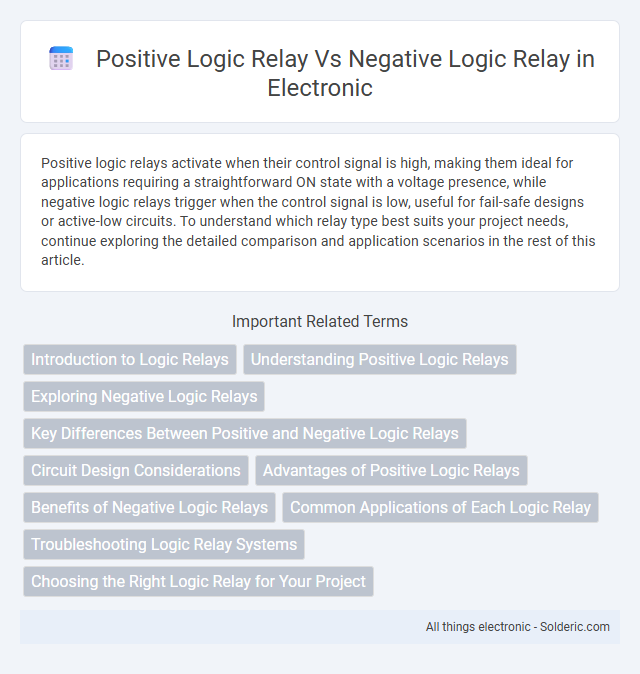Positive logic relays activate when their control signal is high, making them ideal for applications requiring a straightforward ON state with a voltage presence, while negative logic relays trigger when the control signal is low, useful for fail-safe designs or active-low circuits. To understand which relay type best suits your project needs, continue exploring the detailed comparison and application scenarios in the rest of this article.
Comparison Table
| Feature | Positive Logic Relay | Negative Logic Relay |
|---|---|---|
| Activation Signal | High voltage or logic '1' | Low voltage or logic '0' |
| Default State | De-energized (off) at low signal | De-energized (off) at high signal |
| Output Behavior | Relay energizes when input is high | Relay energizes when input is low |
| Common Use | Standard in systems with active high control | Used where active low control is preferred |
| Signal Interpretation | '1' means ON, '0' means OFF | '0' means ON, '1' means OFF |
| Noise Immunity | Better with active high signals | Better in environments using active low logic |
| Typical Applications | Industrial controls, PLCs, microcontrollers | Embedded systems, safety interlocks |
Introduction to Logic Relays
Logic relays function as electrically operated switches that control circuits based on input signals, with positive logic relays activating when a high voltage or signal is present, while negative logic relays activate on a low voltage or absence of signal. Positive logic relays simplify control in systems where a high signal is the default trigger, enhancing clarity in signal processing and reducing misactivation risks. Negative logic relays are preferred in fail-safe designs and low-power electronics, ensuring circuit operation during loss of signal or power interruptions for increased reliability.
Understanding Positive Logic Relays
Positive logic relays activate when a high voltage or logical "1" signal is received, ensuring a clear and straightforward control mechanism in most digital circuits. This type of relay simplifies the interpretation of signals by associating the presence of voltage with an active or "on" state, improving reliability and response time in your control systems. Understanding positive logic relays is essential for designing circuits where signal clarity and intuitive operation are critical for performance.
Exploring Negative Logic Relays
Negative logic relays operate by energizing the coil when the control signal is low or zero voltage, providing a fail-safe mechanism in control systems. These relays enhance system reliability by activating circuit components during signal loss or power failure, contrasting with positive logic relays that activate on a high signal. Negative logic configurations are essential in safety-critical applications where default activation in the absence of a control signal ensures continuous operation and protection.
Key Differences Between Positive and Negative Logic Relays
Positive logic relays activate when the input signal is high (logic 1), whereas negative logic relays engage with a low input signal (logic 0). The key difference lies in their signal triggering method: positive logic relays respond to voltage presence, while negative logic relays react to voltage absence or ground. Understanding this distinction helps you design control circuits with the appropriate relay logic for desired system behavior and reliability.
Circuit Design Considerations
Positive logic relay circuits activate when the input signal is high, requiring careful voltage level matching and proper transistor or MOSFET selection to prevent false triggering. Negative logic relay designs engage on a low input signal, necessitating pull-up resistors and ensuring the control logic can sink sufficient current to energize the relay coil effectively. Your circuit layout should also account for noise immunity and power consumption differences between positive and negative logic configurations for reliable operation.
Advantages of Positive Logic Relays
Positive logic relays offer enhanced noise immunity and faster response times, making them ideal for precise control applications. They simplify circuit design by reducing false triggering and ensuring consistent activation under defined positive voltage conditions. These advantages lead to improved reliability and efficiency in automation systems compared to negative logic relays.
Benefits of Negative Logic Relays
Negative logic relays offer increased noise immunity and reduced power consumption, making them ideal for environments with electrical interference. Their fail-safe design ensures the relay deactivates when the control signal is lost, enhancing system reliability and safety. Negative logic relays are also easier to integrate with digital circuits employing active-low signals, optimizing overall system performance.
Common Applications of Each Logic Relay
Positive logic relays are commonly used in automation systems, industrial control circuits, and digital electronics where signals are active-high, enabling easy integration with microcontrollers and PLCs. Negative logic relays find frequent applications in fail-safe systems, emergency alarms, and power management circuits that rely on active-low signals to ensure safety and reduce false triggering. Both types of relays optimize signal interpretation, with positive logic favored for straightforward signal detection and negative logic crucial for systems requiring inherent safety mechanisms.
Troubleshooting Logic Relay Systems
Positive logic relays activate circuits when input signals are high or ON, simplifying troubleshooting by allowing technicians to verify voltage presence directly at relay coils with standard testing tools. Negative logic relays operate when input signals are low or OFF, requiring testers to check for absence of voltage or ground signals, which can complicate fault diagnosis due to the inverted logic state. Understanding the relay logic type is crucial for efficient troubleshooting, as it dictates signal interpretation and measurement points within the relay control system.
Choosing the Right Logic Relay for Your Project
Choosing the right logic relay for your project depends on the signal conventions and system requirements, where positive logic relays activate with a high signal voltage, while negative logic relays trigger with a low signal voltage. Positive logic relays are ideal for systems designed around active-high control signals, offering straightforward integration with most microcontrollers and digital circuits. Understanding your control logic and ensuring compatibility with your power supply voltage will optimize relay performance and reliability in your automation setup.
Positive logic relay vs negative logic relay Infographic

 solderic.com
solderic.com